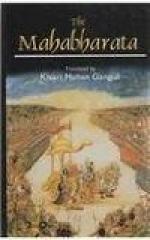sometimes with the mace, sometimes with the heavy
mullets, sometimes with the scimitar, and sometimes
with the battle axe. He it is that assumes the
form of Sesha who sustains the world on his head.
He has snakes for his belt, and his ears are adorned
with ear-rings made of snakes. Snakes form also
the sacred thread he wears. An elephant skin
forms his upper garment.[44] He sometimes laughs and
sometimes sings and sometimes dances most beautifully.
Surrounded by innumerable spirits and ghosts, he sometimes
plays on musical instruments. Diverse, again are
the instruments upon which he plays, and sweet the
sounds they yield. He sometimes wanders (over
crematoria), sometimes yawns, sometimes cries, and
sometimes causes others to cry. He sometimes
assumes the guise of one that is mad, and sometimes
of one that is intoxicated, and he sometimes utters
words that are exceedingly sweet. Endued with
appalling fierceness, he sometimes laughs loudly,
frightening all creatures with his eyes. He sometimes
sleeps and sometimes remains awake and sometimes yawns
as he pleases. He sometimes recites sacred Mantras
and sometimes becomes the deity of those Mantras which
are recited. He sometimes performs penances and
sometimes becomes the deity for whose adoration those
penances are undergone. He sometimes makes gifts
and sometimes receives those gifts; sometimes disposes
himself in Yoga and sometimes becomes the object of
the Yoga contemplation of others. He may be seen
on the sacrificial platform or in the sacrificial
stake; in the midst of the cow-pen or in the fire.
He may not again be seen there. He may be seen
as a boy or as an old man. He sports with the
daughters and the spouses of the Rishis. His hair
is long and stands erect. He is perfectly naked,
for he has the horizon for his garments. He is
endued with terrible eyes. He is fair, he is darkish,
he is dark, he is pale, he is of the colour of smoke,
and he is red. He is possessed of eyes that are
large and terrible. He has empty space for his
covering and he it is that covers all things.
Who is there that can truly understand the limits
of Mahadeva who is formless, who is one and indivisible,
who conjures of illusions, who is of the cause of all
actions and destructive operations in the universe,
who assumes the form of Hiranyagarbha, and who is
without beginning and without end, and who is without
birth.[45] He lives in the heart (of every creature).
He is the prana, he is the mind, and he is Jiva (that
is invested in the material case). He is the
soul of Yoga, and it is that is called Yoga. He
is the Yoga-contemplation into which Yogins enter.[46]
He is the Supreme Soul. Indeed Maheswara, the
purity in essence, is capable of being comprehended
not by the senses but through only the Soul seizing
his existence. He plays on diverse musical instruments.
He is a vocalist. He has a hundred thousand eyes,
he has one mouth, he has two mouths, he has three
mouths, and he has many mouths. Devoting thyself




